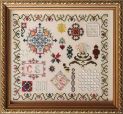|
Cross Stitch is found throughout the world. It is extremely versatile, has a crisp texture
and is well suited to pictorial and abstract designs. If worked on a small scale (large count
fabric and over one thread), it can produce fine detail, delicate effects, and subtle
shading.
In the English speaking countries cross stitch is used mostly in pictorial work, a tradition
reaching back into the 18th century, when it became the popular stitch for samplers. Early samplers
were simply a collection of different embroidery stitches, worked on long pieces of linen and kept
by the embroiderer as a reference. Gradually samplers became more pictorial in nature, consisting
of motifs arranged within a border. Birds, flowers, trees, houses, and patriotic images, such as
the American eagle, were popular motifs. Making a sampler soon became part of a young girl's
education. Such samplers included and alphabet, numerals, a pious verse, as well as the date and
the stitcher's name.
Even though a variety of stitches is used on these samplers, cross stitch tended to dominate. It was
almost always used for the floral borders, which typically depicted an undulating stem or vine bearing
stylized roses, carnations, or other blooms.
Stylized natural forms, sometimes almost unrecognizable, are worked in cross stitch on the native
costumes of many peoples, including Eastern European, Morocco and parts of the Middle East.
In cross stitch embroidery the stitches form the motif and the background is left plain. Just the
reverse of Assisi embroidery.
|
